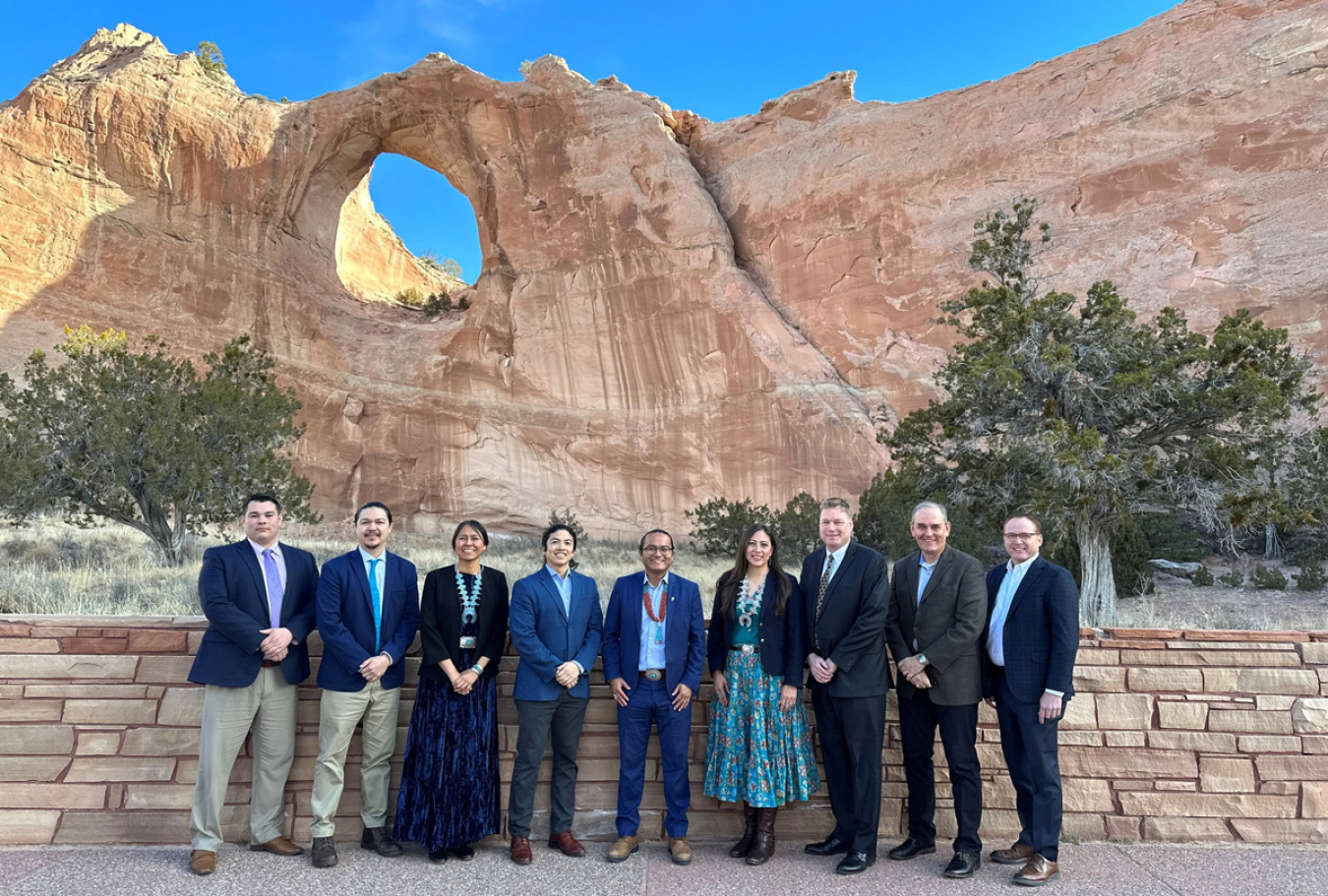A new Memorandum of Understanding (MOU) between the federal government and the Navajo Nation aims to ease tribal access to federal funding.
Office of Indian Energy Policy and Programs
August 14, 2023Multi-Year, Multi-Agency Deal Seeks to Ease Tribal Access to Historic Federal Funding
In 1936, Congress passed the Rural Electrification Act to give rural Americans a "fair chance"[1] under the New Deal. But that deal did not extend to the Diné.[2]
To this day, more than a quarter of the 55,000 households on the Navajo Nation, which comprises 27,400 square miles of rural land in Arizona, New Mexico, and Utah, remain off the grid.[3]

A new Memorandum of Understanding (MOU) between the federal government and the Tribe could begin to change that. The multi-year agreement aims to ease tribal access to federal funding available through the Creating Helpful Incentives to Produce Semiconductors (CHIPS) and Science Act, the Inflation Reduction Act (IRA), and the Bipartisan Infrastructure Law (BIL).
The MOU is the cornerstone of a broader initiative, spearheaded by the Office of Indian Energy, that aims to give tribes transitioning from coal-centric to clean energy economies a fair chance of benefiting from the federal funding made available for a wide range of infrastructure and economic development projects.
Signed by the Navajo Nation, the U.S. Department of Energy (DOE), and other federal agencies, the MOU launched a multi-year, multi-agency effort to boost prosperity and improve quality of life on the Navajo Nation.
Energy Extraction Raised Revenues, Exported Power
The Navajo Nation is rich in energy resources, including coal, uranium, and solar. But historically, the vast majority of power produced there has flowed across Navajo lands to urban centers off the Reservation. For decades, resource extraction and power generation on the Navajo Nation have largely benefited other communities, while the Diné have borne outsized burdens, including heavy health and environmental impacts.
Without broad access to the power that fuels modern economies and is a standard of living across most of America, prospering in their "permanent homeland"[4] is an ongoing challenge for Diné communities. Tribal members without access to electricity face acute quality-of-life impacts that contribute to the significant hurdles the Tribe faces on the path to prosperity.
Among the long-standing struggles that stymie well-being on the Reservation, high poverty, steep unemployment, and historic underdevelopment take a heavy toll. But the Salt River Project’s financial decision to close the Navajo Generating Station (NGS) in 2019[5] dealt a devastating blow to the Nation’s economy. Approximately 1,000 people lost their jobs and the closure also significantly reduced tribal revenue, impacting all facets of the tribal economy.
Hope Floats, and Navajo Steps on Board
Seeking to diversify and transition its energy economy in the wake of the NGS closure, the Navajo Nation was one of three U.S. tribes that applied for Economic Development Administration (EDA) grants to support communities transitioning away from coal. Only one, the Hopi Tribe, received an EDA award.
Identifying a need, the Office of Indian Energy conceived a plan to bolster tribal efforts to capitalize on the opportunities afforded by historic levels of federal funding available under the CHIPS and Science Act, the BIL, and the IRA.
"The Office of Indian Energy wanted to create a structure to help ensure tribes can leverage the once-in-a-generation federal funding aimed at increasing prosperity and enhancing well-being in underserved and struggling communities across the United States," said Office of Indian Energy Director Wahleah Johns.
The Office of Indian Energy’s plan focuses on establishing MOUs with tribes embarking on energy transitions away from coal. "Our intent was to amass available federal resources and make sure tribes are aware they exist and can access them," said Office of Indian Energy Deployment Specialist Dr. Tommy Jones.

Johns and Jones, who serve on the White House Council on Native American Affairs, floated the idea before their Energy, Economic Development, and Infrastructure subgroup. "The White House staff and all of the federal agency participants were immediately receptive," said Jones.
Buoyed by the broad support on the federal side, the Office of Indian Energy launched their MOU initiative.
"Tribes like the Navajo Nation and Hopi Tribe have played a critical role in powering the West for 50 years, and we are excited to support them to lead the way toward this clean energy transition for decades to come," said Director Johns.
The Navajo Tribal Council brought the Office of Indian Energy’s proposal to a vote and moved it forward right away. And on December 1, 2022, former Navajo Nation President Johnathan Nez signed the MOU alongside Energy Secretary Jennifer Granholm.
A Plan Developed by and for the Navajo Nation
With that, the MOU signatories had 180 days to develop an Implementation Plan. With the full support of incoming Navajo Nation President Buu Nygren, they got to work convening a broad and diverse set of Navajo Nation stakeholders, including tribal leaders and staff, tribal businesses, and tribal nonprofits. Tribal stakeholders were joined by representatives from the White House and various federal offices at a series of three in-person planning meetings held on Navajo Nation in the spring.
In building relationships through this process, explained Jones, the MOU enables diverse stakeholders to find common ground and bring different strengths to bear, bridging gaps in capacity that can be barriers to success. For example, tribal entities may have limited experience applying for grants, community members may have had minimal access to a computer, and nonprofits may not be eligible for federal funding.
"Tribal-led nonprofits and non-governmental organizations will play a pivotal role, partnering closely with the Tribe to secure funding and implement the projects," said Jones. "They have the capacity and motivation to carry out projects, and they can get letters of support from President Nygren, which will strengthen their applications [for relevant federal grants that require partnership with a tribe or other eligible entity]."
The initial goal was to identify which infrastructure projects are achievable within a 2-year time frame. "The MOU has a 4- to 5-year timeline, so the strategy is to get short-term wins while the funding is flowing," Jones said. "We started with 80 ideas and narrowed it down to 34 priority projects."
Although the MOU doesn’t give Navajo priority status when applying for federal funding, Jones said the goal is "to help ensure the Navajo Nation isn’t left behind and is supported throughout the process."
The Implementation Plan is now in the hands of Secretary Granholm for review. "This [plan] is developed by and for the Navajo Nation," Jones said. "The Office of Indian Energy is supporting Navajo-led initiatives so positive things can happen on Navajo [Nation]. We’re working with them, not telling them what to do."
When Tribes Succeed, Everyone Wins
"This was unprecedented on Navajo [Nation]," said Jones, referring to the collaborative, consensus-based community planning process and underscoring its powerful role in advancing Diné efforts to shape their self-determined energy future. "When tribes succeed in developing clean energy, tribal communities prosper and thrive. And that helps with American energy security, grid resilience, and job creation on a broader scale."
It’s a fair chance for the Diné, and a good deal for America.
Footnotes
Click the linked numbers below to return to the note's location in the main text.
[1] In a Special Session of Congress on July 4, 1861, President Abraham Lincoln said the purpose of the U.S. government was "to elevate the condition of men—to lift artificial weights from all shoulders—to clear the paths of laudable pursuit for all—to afford all, an unfettered start, and a fair chance, in the race of life." In the 1930s, concerned that rural Americans were not getting a "fair chance," U.S. Senator George Norris of Nebraska lamented that in rural America the men and women were "growing old prematurely; dying before their time; conscious of the great gap between their lives and the lives of those whom the accident of birth or choice placed in towns and cities." Convinced that access to electricity would revolutionize the rural way of life, he and others passed the Rural Electrification Act of 1936.
[2] The Diné (Navajo People) are also referred to as Navajo "Indians" a name not used or liked by the People. The Navajo prefer to be called the "Diné" meaning "The People" or "Children of the Holy People."
[3] American Public Power Association.
[4] Navajo Nation Treaty of 1868.
[5] Lustgarten, Abrahm. 2015. “Navajo Generating Station Powers and Paralyzes the Western U.S.” Scientific American; Storrow, Benjamin. 2019. “And Now the Really Big Coal Plants Begin to Close.” Scientific American.
Karen Petersen

Karen Petersen is a communications strategist in the National Renewable Energy Laboratory’s Communications & Public Affairs Office. With more than 25 years of private-sector experience in publishing and marketing, Ms. Petersen specializes in writing, editing, strategic communications planning, and brand development. In addition to serving as the Tribal Energy Program communications lead from 2010 through 2015, she actively supported the development of the DOE Office of Indian Energy’s communications strategy, brand identity, and outreach materials. Ms. Petersen also served as the communications lead for DOE-led clean energy initiatives in Hawaii and the U.S. Virgin Islands.

